Jigsaw puzzle
| Part of a series on |
| Puzzles |
|---|
 |
A jigsaw puzzle is a tiling puzzle that requires the assembly of often oddly shaped interlocking and tessellating pieces. Each piece usually has a small part of a picture on it; when complete, a jigsaw puzzle produces a complete picture. In some cases more advanced types have appeared on the market, such as spherical jigsaws and puzzles showing optical illusions.
Jigsaw puzzles were originally created by painting a picture on a flat, rectangular piece of wood, and then cutting that picture into small pieces with a jigsaw, hence the name. John Spilsbury, a London cartographer and engraver, is credited with commercializing jigsaw puzzles around 1760.[1] Jigsaw puzzles have since come to be made primarily of cardboard.
Typical images found on jigsaw puzzles include scenes from nature, buildings, and repetitive designs. Castles and mountains are two traditional subjects. However, any kind of picture can be used to make a jigsaw puzzle; some companies offer to turn personal photographs into puzzles. Completed puzzles can also be attached to a backing with adhesive to be used as artwork.
During recent years, a range of jigsaw puzzle accessories including boards, cases, frames and roll-up mats has become available that are designed to assist jigsaw puzzle enthusiasts.
History

The engraver and cartographer John Spilsbury, of London, is believed to have produced the first jigsaw puzzle around 1760, using a marquetry saw.[1] Early jigsaws, known as dissections, were produced by mounting maps on sheets of hardwood and cutting along national boundaries, creating a puzzle useful for the teaching of geography.[1] Such "dissected maps", were used to teach the children of King George III and Queen Charlotte by royal governess Lady Charlotte Finch.[4][5]
The name "jigsaw" came to be associated with the puzzle around 1880 when fretsaws became the tool of choice for cutting the shapes. Since fretsaws are distinct from jigsaws, the name appears to be a misnomer.[1] Cardboard jigsaw puzzles appeared during the late 1800s, but were slow to replace the wooden jigsaw due to the manufacturer's belief that cardboard puzzles would be perceived as being of low quality, and the fact that profit margins on wooden jigsaws were larger.[1]
Jigsaw puzzles soared in popularity during the Great Depression, as they provided a cheap, long-lasting, recyclable form of entertainment.[1][6] It was around this time that jigsaws evolved to become more complex and more appealing to adults.[1] They were also given away in product promotions, and used in advertising, with customers completing an image of the product being promoted.[1][6]
Sales of wooden jigsaw puzzles fell after World War II as improved wages led to price increases, while at the same time improvements in manufacturing processes made cardboard jigsaws more attractive.[6]
According to the Alzheimer Society of Canada, doing jigsaw puzzles is one of many activities that can help keep the brain active and may contribute to reducing the risk of developing Alzheimer's disease.[7]
Modern construction
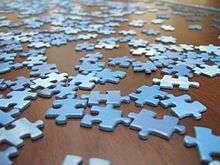
Most modern jigsaw puzzles are made out of paperboard since they are easier and cheaper to mass-produce than the original wooden models. An enlarged photograph or printed reproduction of a painting or other two-dimensional artwork is glued onto the cardboard before cutting. This board is then fed into a press. The press forces a set of hardened steel blades of the desired shape through the board until it is fully cut. This procedure is similar to making shaped cookies with a cookie cutter. The forces involved, however, are tremendously greater and a typical 1000-piece puzzle requires a press that can generate upwards of 700 tons of force to push the knives of the puzzle die through the board. A puzzle die is a flat board, often made from plywood, which has slots cut or burned in the same shape as the knives that are used. These knives are set into the slots and covered in a compressible material, typically foam rubber, which serves to eject the cut puzzle pieces.
Beginning in the 1930s, jigsaw puzzles were cut using large hydraulic presses which now cost in the hundreds of thousands of dollars. The cuts gave a very snug fit, but the cost limited jigsaw puzzle manufacture only to large corporations. Recent roller press design achieve the same effect, at a lower cost. By the early 1960s, Tower Press was the world's largest maker of jigsaw puzzles, acquired by Waddingtons in 1969.[8]
New technology has enabled laser-cutting of wooden or acrylic jigsaw puzzles. The advantage of cutting with a laser is that the puzzle can be custom cut into any size, any shape, with any size (or any number) of pieces. Many museums have laser cut acrylic puzzles made of some of their more important pieces of art so that children visiting the museum can see the original piece and then assemble a jigsaw puzzle of the image that is also in the same shape as the piece of art. Acrylic is used because the pieces are very durable, waterproof, and can withstand continued use without the image fading, or the pieces wearing out, or becoming frayed. Also, because the print and cut patterns are computer based, lost pieces can be manufactured without remaking the entire puzzle.
Variations
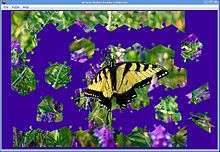
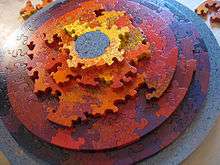
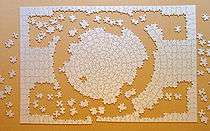
Jigsaw puzzles come in a variety of sizes. Smaller puzzles are often considered to be those of 300, 500, and 750 pieces. More sophisticated, but still common, jigsaw puzzles come in sizes of 1,000, 1,500, 2,000, 3,000, 4,000, 5,000, 6,000, 7,500, 8,000, 9,000, 13,200, 18,000, 24,000, 32,000 and 40,000 pieces. There are also smaller jigsaw puzzles that are geared towards children, and are rated by the number of pieces they contain.
The most common layout for a thousand-piece puzzle is 38 pieces by 27 pieces, for a total count of 1,026 pieces. The majority of 500-piece puzzles are 27 pieces by 19 pieces. A few puzzles are made double-sided, so that they can be solved from either side. This adds a level of complexity, because it cannot be certain that the correct side of the piece is being viewed and assembled with the other pieces.
"Family puzzles" come in 100-550 pieces with three different sized pieces from large to small. The pieces are placed from large to small going in one direction or towards the middle of the puzzle. This allows a family of puzzlers of different skill levels and different-sized hands to work on the puzzle at the same time. Companies like Springbok, Cobble Hill, Ravensburger, and Suns Out make this type of specialty puzzle.
There are also three-dimensional jigsaw puzzles. Many of these are made of wood or styrofoam and require the puzzle to be solved in a certain order; some pieces will not fit in if others are already in place. Also common are puzzle boxes: simple three-dimensional jigsaw puzzles with a small drawer or box in the center for storage.
Another type of jigsaw puzzle, which is considered a 3-D puzzle, is a puzzle globe. Like a 2-D puzzle, a globe puzzle is often made of plastic and the assembled pieces form a single layer. But the final form is a three-dimensional shape. Most globe puzzles have designs representing spherical shapes such as the Earth, the Moon, and historical globes of the Earth.
There are also computer versions of jigsaw puzzles, which have the advantages of requiring zero cleanup as well as no risk of losing any pieces. Many computer-based jigsaw puzzles do not allow pieces to be rotated, so all pieces are displayed in their correct orientation. These puzzles are thus considerably easier than a physical jigsaw puzzle with the same number of pieces. A computer puzzle website can allow users to choose their own puzzle size, cut design, and image, or upload their own images to use as puzzles.[9] An online jigsaw version of Trolleholm Castle in Sweden may be worked and timed for speed of finishing.[10] The New Yorker Magazine subscription website preserves images of the magazine's cover illustrations as jigsaw puzzles which are timed and offer several levels of difficulty.
In 2016 was introduced a computer version of puzzle globe, the immersive panorama jigsaw, which is based on the use of equirectangular images taken by 360-degree camera. Despite the physical spherical jigsaw, the player, who resides in the perfect center of the globe, assembles triangular shaped interlocking pieces around him. When complete, this puzzle produces a full-degree panorama all around the player. An example of immersive jigsaw is Sitespot, which also enriches the gaming experience with the scene soundscape and allows pieces to be displayed rotated.
Jigsaw puzzles can vary greatly in price depending on the complexity, number of pieces, and brand. Children's puzzles can be as cheap as around $5.00 while larger puzzles can be closer to $50.00. The most expensive puzzle to date was sold for $27,000 in 2005 at a charitable auction for The Golden Retriever Foundation.[11]
Several word puzzle games use pieces similar to those used in jigsaw puzzles. Examples include Alfa-Lek, Jigsaw Words, Nab-It!, Puzzlage, Typ-Dom, Word Jigsaw, and Yottsugo.[12]
Puzzle pieces
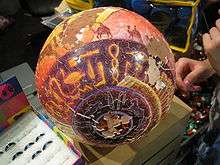
Many puzzles are termed "fully interlocking". This means that adjacent pieces are connected in such a way that if one piece is moved horizontally, the other pieces move with it, preserving the connection. Sometimes the connection is tight enough to pick up a solved part by holding one piece.
Some fully interlocking puzzles have pieces all of a similar shape, with rounded tabs out on opposite ends, with corresponding blanks cut into the intervening sides to receive the tabs of adjacent pieces. Other fully interlocking puzzles may have tabs and blanks variously arranged on each piece, but they usually have four sides, and the numbers of tabs and blanks thus add up to four. The uniform-shaped fully interlocking puzzles, sometimes called "Japanese Style", are the most difficult, because the differences in shapes between pieces can be very subtle.
Most jigsaw puzzles are square, rectangular, or round, with edge pieces that have one side that is either straight or smoothly curved to create this shape, plus four corner pieces if the puzzle is square or rectangular. Some jigsaw puzzles have edge pieces that are cut just like all the rest of the interlocking pieces, with no smooth edge, to make them more challenging. Other puzzles are designed so the shape of the whole puzzle forms a figure, such as an animal. The edge pieces may vary more in these cases.
The pieces of spherical jigsaw, like immersive panorama jigsaw, can be triangular shaped, according to the rules of tassellation of the geoid primitive.
World records
The world's largest commercially available jigsaw puzzle was released by German company Ravensburger in September 2016. It shows 10 scenes from Disney works and has 40,320 pieces, measuring 680 cm by 192 cm when assembled.[13] The world's largest-sized jigsaw puzzle measured 5,428.8 m2 (58,435 sq ft) with 21,600 pieces, each measuring a Guinness World Records maximum size of 50 cm by 50 cm. It was assembled on 3 November 2002 by 777 people at the former Kai Tak Airport in Hong Kong.[14]
The jigsaw with the greatest number of pieces had 551,232 pieces and measured 14.85 x 23.20 m (48 ft 8.64 in x 76 ft 1.38 in). It was assembled on 24 September 2011 at Phú Thọ Indoor Stadium in Ho Chi Minh City, Vietnam, by students from the University of Economics, Ho Chi Minh City.[15][16]
Cultural significance

The logo of Wikipedia is a globe made out of jigsaw pieces. The incomplete sphere appears to have some pieces missing, symbolizing the room to add new knowledge.
Art and entertainment
The central antagonist in the Saw film franchise is named Jigsaw.[17]
In the 1933 Laurel and Hardy short Me and My Pal, several characters attempt to complete a large jigsaw puzzle.[18]
Symbol for autism
Jigsaw puzzle pieces were first used as a symbol for autism in 1963 by the United Kingdom's National Autistic Society.[19] The organization chose jigsaw pieces for their logo to represent the "puzzling" nature of autism and the inability to "fit in" due to social differences, and also because jigsaw pieces were recognizable and otherwise unused.[20] Puzzle pieces have since been incorporated into the logos and promotional materials of many organizations, including the Autism Society of America and Autism Speaks.
Proponents of the autism rights movement oppose the jigsaw puzzle iconography, stating that metaphors such as "puzzling" and "incomplete" are harmful to autistic people. Critics of the puzzle piece symbol instead advocate for a rainbow-colored infinity symbol representing diversity.[21]
See also
- Jigsaw puzzle accessories
- Life a User's Manual
- Lost in Translation (poem)
- Tessellation
- Three-dimensional edge-matching puzzle
References
| Wikimedia Commons has media related to Jigsaw puzzle. |
- 1 2 3 4 5 6 7 8 McAdam, Daniel. "History of Jigsaw Puzzles". American Jigsaw Puzzle Society. Archived from the original on 19 Oct 2000. Retrieved 13 October 2014.
- ↑ "The Time of the Jigsaws". BBC. 15 November 2016.
- ↑ "Top 10 facts about jigsaw puzzles". Daily Express. 15 November 2016.
- ↑ Historic Royal Palaces press release "Jigsaw cabinet"
- ↑ http://collections.vam.ac.uk/item/O1243701/puzzle-cabinet-unknown/ V&A collection; Museum number:B.1:1 & 2-2011; puzzle cabinet
- 1 2 3 Williams, Anne, D. "Jigsaw Puzzles - A Brief History". http://www.mgcpuzzles.com/. Retrieved 2 August 2014. External link in
|website=(help) - ↑ Healthy Brain Alzheimer Society of Canada Accessed 30 March 2011
- ↑ Achievement. World Trade Magazines Ltd. 1962. p. 31. Retrieved 3 April 2013.
- ↑ "Online Jigsaw Puzzles". Jigzone. Retrieved 13 October 2014.
- ↑ "Trolleholm Castle, Sweden jigsaw puzzle". TheJigsawPuzzles.com. Retrieved 30 November 2016.
- ↑ "Most expensive jigsaw puzzle sold at auction". Guinness World Records. Retrieved 2016-03-06.
- ↑
- ↑ "Largest commercial jigsaw puzzle - most pieces". Guinness World Records. 2010-09-01. Retrieved 2013-03-04.
- ↑ "Largest jigsaw puzzle". Guinness World Records. 2002-11-03. Retrieved 2013-03-04.
- ↑ "Largest jigsaw puzzle - most pieces". Guinness World Records. Retrieved 15 March 2017.
- ↑ "Vietnam puts together the world’s largest jigsaw puzzle". Guinness World Records News. Retrieved 15 March 2017.
- ↑ ""Saw" IMDB page". Internet Movie Database. 2004-10-29.
- ↑ ""Me and My Pal" IMDB page". Internet Movie Database. 2015-08-29.
- ↑ "NAS timeline (text only version)". National Autistic Society. 2013-02-15.
- ↑ "The History of the Autism Ribbon Symbol". Health Guide Info. 2011-05-13.
- ↑ Lisa D. (full last name unknown) (2012-05-02). "I am not a puzzle: From Reports from a Resident Alien". Unpuzzled.
External links
- Jigsaw-puzzle.org at Wayback Machine (Nov. 2000)
- Jigsaw puzzle resources
- Free Online Jigsaw puzzles